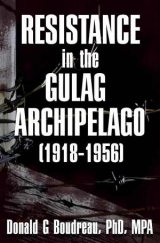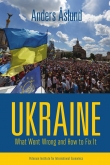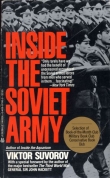
Текст книги "Resistance in the Gulag Archipelago"
Автор книги: Donald Boudreau
Жанр:
История
сообщить о нарушении
Текущая страница: 1 (всего у книги 4 страниц)
RESISTANCE IN THE GULAG ARCHIPELAGO (1918-1956)
By Donald G. Boudreau, PhD, MPA
How miserable is a society that knows no better means of defense than an executioner.
– Karl MarxAs quoted by Albert Camus in Camus’,The Rebel: An Essay on Man in Revolt, at 240.
INTRODUCTION
Back in the balmy summer of 1974, I spent many hot and humid nights working as a waiter in a steakhouse restaurant, out on the highway known as US Rt. 22, in northern New Jersey. In arriving home thereafter, late in the evening to a nearby suburb, feeling wired and needing to unwind before sleeping, I began bedtime reading a significant number of works authored by Alexander Solzhenitsyn. Solzhenitsyn had been receiving substantial media attention then, regarding his published release a year earlier in 1973 of the first volume of his highly acclaimed The Gulag Archipelago, depicting life and death in the Soviet prison labor camp system during the years 1918-1956.
Given his, Solzhenitsyn’s firsthand perspective of the harsh life therein the Gulag camps, and reading his lightly fictionalized accounts contained in his many novels and stories and poems authored, I thought it would be useful in exploring the question as to how resistance manifested itself in its many ways among the inmates in the Gulag camps. I set about to doing so through reading the works of Solzhenitsyn and some other observers including noted historians of that particular era, whose writings depicted or otherwise memorialized authoritative experiences, acts of dissenting, protesting, and resisting that had occurred in the Gulag during those years.
In the fall of 1974, while preparing my senior college thesis for the advanced Scope and Methods in Political Science course at Montclair State College (now University) in Upper Montclair, New Jersey, on this very same subject, the senior requirement for a Political Science Major culminated in the student presenting an hour long oral presentation of the same written thesis of some serious length manuscript, before and in front of the entire classroom audience, comprised of the course’s professor and one’s fellow students.
My dear friend and fellow classmate, Janet Serra, just days before my scheduled senior presentation before the class, kindly presented me with an early surprise birthday present. It was a first edition, hardcover of the just released volume one of Solzhenitsyn’s The Gulag Archipelago. She was also, admittedly, sparing me in the process she had rightly said, the shamelessly classless embarrassment of having to read excerpts of the same, from my much worn and rabbit eared, paperback edition, during my hour long class presentation that she knew I was to be delivering soon before the entire class.
Thereafter, my professor, the now since retired Dr. George T. Menake, Emeritus Professor of Political Science at Montclair State University, kindly recommended to me in the months thereafter upon returning the graded paper with comments, that he thought I might seriously wish to consider “publishing the paper someday”, which of course, at the time, I did not do so, that is until this day, as this is largely that same very paper verbatim with some incidental, minor cosmetic changes, which you now have before you.
Although granted, publishing this paper now represents somewhat of a thirty-eight year delay in following up on his, Professor Menake’s most thoughtful, prescient suggestion. But while some of the writing here may strike some as a bit dated, given the 1989 collapse of the Soviet Union and other related reforms, the topic here presented nonetheless remains valid in our present day, given the worthwhile value in learning more regarding the many ways, creative and otherwise, in which victims historically have gone about resisting tyrannical and totalitarian regimes, worldwide. It is also noteworthy from the standpoint that many observers believe that Russia, the now former Soviet Union, has yet to come to grips with addressing and accepting the truths, the history of Stalin as a leader, and the Stalinist era and that of the Gulag camps, in all of their unvarnished cruelty and horror. See for example, in this regard Fred Hiatt, “Russians Seek Rosier Past, Even Revising Stalin Image,” [“Russians are romanticizing their prerevolutionary era and have even begun to question whether Joseph Stalin and his gulag were as monstrous as perestroika-era revelations suggested.”], The Washington Post, October 30, 1994, p. A31, col. 1, bold added. As David Satter (2011) powerfully observes in It Was A Long Time Ago, and It Never Really Happened Anyway: Russia and the Communist Past(New Haven, CT: Yale University Press) the elemental failing of Russia’s leaders and people is their refusal in facing the moral depravity of its Soviet past, including its most savage manifestation: Joseph Stalin’s terror.
My appreciation for the accomplishments of Alexander Solzhenitsyn as a gifted writer (he was awarded the 1970 Nobel Prize in Literature), and as an exhaustively detailed historian of life in Stalinist Russia, has only increased over the several intervening decades. Towards the end of his life, Solzhenitsyn lived in a comfortable compound in nearby Moscow, and was very supportive of organizations providing for the welfare of survivors from the Gulag camps. In supporting their works, Solzhenitsyn was known to make appearances at the Moscow-based offices of such in order to autograph copies of his books; the proceeds of which went to benefiting the victims and their families of those who had, somehow too, survived life in the various Gulag camps, as Solzhenitsyn himself knew well having himself experienced such firsthand.
Fortunately, and thanks to a reputable fine book dealer based in Connecticut who frequented such events in Moscow, I am today the proud owner of the prized possessions of not one, but two rather, beautifully signed copies of Solzhenitsyn’s The Gulag Archipelago, which I have every intention of bequeathing as invaluable family heirlooms to be treasured and passed on, in turn, by my two beloved children, Katarina and Joseph.
Moreover and finally, given their aforementioned personal contributions made in the fall semester of 1974 to furthering the work of this paper, it is only fitting that I dedicate it here to them both: in ever loving memory of my late beloved dear friend, Janet Serra, for her much valued warm friendship and countless kindnesses. And for his steadfast encouraging support to the much respected scholar, Dr. George T. Menake, Emeritus Professor of Political Science, Department of Political Science and Law, Montclair State University, Upper Montclair, New Jersey, may he have a healthy, long, happy and fruitful retirement. “Thank you” both sincerely Janet and George, this one’s for you two!
Dr. Donald G. Boudreau
Fredericksburg, Virginia
Summer 2012
LAKE SEGDEN
…Here is somewhere to settle forever, a place where a man could live in harmony with the elements and be inspired. But it cannot be. An evil prince, a squint-eyed villain, has claimed the lake for his own: there is his house, there is his bathing place. His evil brood goes fishing here, shoots ducks from his boat. First a wisp of blue smoke above the lake, then a moment later the shot.
Away beyond the woods, the people sweat and heave, whilst all the roads leading here are closed lest they intrude. Fish and game are bred for the villain’s pleasure. Here there are traces where someone lit a fire but it was put out and he was driven away.
Beloved, deserted lake.
My native land…
– Alexander I. Solzhenitsyn (1972)Excerpted in part from “Lake Segden,” in Solzhenitsyn, Stories and Prose Poems, at 198-9.
I dedicate this
to all those who did not live
to tell it.
And may they please forgive me
for not having seen it all,
for not having divined all of it.
So begins The Gulag Archipelago, Alexander Solzhenitsyn’s history of Soviet police terror and the sub-human prison camp network. It is less important for what it says then for what it leaves unsaid. This detailed account of living death in the Soviet Union from 1918 to 1956 takes on its true importance from the suggestion that the police system it describes continues to this day. The infamous network of slave labor camps remains in operation, even if the numbers imprisoned have been vastly reduced, since the amnesties granted during the Nikita Khrushchev regime.
One day, Mr. Solzhenitsyn clearly hoped, his account shall play a role in bringing the Soviet people to rise up and end the decades of oppression which they have so far accepted with such docility. That day is unlikely to come soon as Solzhenitsyn indicates, for the Soviet secret police is the central vital element-even more perhaps than the Communist party machine—in binding the Soviet system together.
The network of camps, prisons, communication facilities, transportation systems and spying organizations, Solzhenitsyn reports, “honeycombs” the length and breadth of the Soviet Union. It appears that no Soviet citizen is ever more than a short distance from some link of this pervasive apparatus of control that permeates all governmental, party and social organizations. The survival of this infrastructure makes it less significant that the actual prison camp population has fallen from an estimated twelve million during Stalin’s reign of terror to perhaps one million today.
Much of what Solzhenitsyn reports had long been known in the West. Yet, this was the first time that an authoritative voice of stature has spoken from Moscow itself to inform the Soviet people in detail of their tragedy and to call for punishment of its perpetrators. Solzhenitsyn’s courageous challenge to the overwhelming power of the police state is a political act without real precedent in the fifty-odd years since the Bolshevik Revolution.
Solzhenitsyn has shown us that his mission is not merely to accuse but rather, to search for remedies that would help the individual overcome the suppression and fear found in a totalitarian regime. My conceptual framework indicates that Stalin was not engaged in a real struggle with counter-revolutionaries. Logic dictates that Stalin acted inimically to his own revolutionary calling.
The main tendency of Stalinist mass repression during the period 1936-1938 was an assault on the Party, on old Bolshevik cadres, on proletarian revolutionaries, on the intelligentsia that were honorably serving the interests of the masses. This study centers upon the question of resistance, dissent, and protest in The Gulag Archipelago. The question reiterates through our minds as it had that of Solzhenitsyn’s – “But can there really be a whole nation of fools?”
My orientation vehemently conjectures that economic and social progress would have been much greater if Stalin had not destroyed thousands upon thousands of scientists, engineers, teachers, doctors, and writers. The solidarity between the people and the government would have been much stronger had there been no mass repression. The people would have shown the Central Committee more confidence if the beau monde in the Party, government, economic and military apparatus had not been destroyed in the mid-thirties. Stalin can no longer be placed alongside Marx, Engels, and Lenin. He must stand alone.
The question usually asked by outsiders, [W]hy did the Jews of Nazi Germany not offer more resistance?” becomes radically obscene in the face of the Warsaw Ghetto Uprising and Treblinka. Granted, there was never an exodus of a major part of the Jews of the ghettos, but in 1942-1943 as the eastern ghettos were being destroyed, small groups of Jews escaped to the woods in a desperate bid for survival and vengeance.
Where is the Warsaw Ghetto Uprising of the Stalinist reign of terror? Where are the six hundred prisoners armed with stolen guns and grenades attacking the Nazi guards, literally blowing up the death houses at Treblinka, and fleeing into the nearby Polish forests? Where are the suicide missions? How could the Russian people have gone to their incarceration, torture, and slaughter like lambs? Was fear of government retaliation so pervasive in the Soviet mind that it negated any and all forms of resisting, dissenting, and protesting? Why did the Jews, despite their relative few in number and the lateness of the hour, arm themselves in rebellion, while the Soviets of this period appear as pacifists in the face of a system which exemplified dialectical terrorism?
Nazi anti-Semitism condemned the Jews as an “alien element” in the body of the nation, thus making them a merciless target of any punishment the deranged minds of totalitarian nationalists were capable of inventing with the help of modern technology. Somewhat similarly, totalitarian Communism condemns the “class enemy” as an alien element within the society. And a madly totalitarian regime, such as Stalin’s, is capable of dealing with it accordingly.
What makes the critical analysis of these atrocious modern evils often so difficult is that they are connected with highly popular, ideologies and mass movements. The idea of nationalism is history’s “first world religion,” as the late Hans Kohn so aptly referred to it. And, to all evidence, the so-called Marxist class structure too is well underway to becoming another world religion. Small wonder it is that even the most articulate and intelligent critics of such successful movements are easily sidetracked. There is, of course, no lack of clear-sighted and courageous commentators on contemporary affairs who are placing these brutal phenomena of our century in proper critical and realistic perspective. Rather, what is lacking is the public ability and willingness to listen to them.
Critics of nationalism and class struggle, not surprisingly, have a particularly difficult time in getting their intellectual messages across in the vulgar confusion of modernity. Two of the worst holocausts of our time, the Hitlerism and the Stalinist – are causes in point to illustrate the ideological malaise which is worldwide.
This paper is write in the hopes that students of law and politics and public administration will seek to confront these “diseases” and “treat” them by educating the public as to their horrendous ramifications. It is unfair to ask more in light of the limitations of the human condition.
This venture is three-fold. First, we will be examining the historically isolated incidents of resistance as they became manifest in the Gulag Archipelago. The relative assessment will prove hopefully to be more precise by referring to historical works of the era such as Roy A. Medvedev’s Let History Judge: The Origins and Consequences of Stalinism(1972) and The Russian Revolution(1966) by Robert Goldston, in addition to our primary source of The Gulag Archipelago(1973) by Alexander Solzhenitsyn.
Second, we will be presenting a literary depiction of resistance in the Gulag camps through two of Alexander Solzhenitsyn’s finest novels, Cancer Ward(1972) and The First Circle(1972). With Solzhenitsyn as a survivor of eight years in concentration camps and three years in exile for his offense (written derogatory remarks about Stalin), his account of literal occurrences is taken here to be nothing short of certitude.
Third and finally, in a state of hopeful culmination, the hypothesis will bear fruit. That being, if there exist no governmental implementation and public support of a criminal justice system acting in the interests of all the people (i.e., the rule of law) then dissent shall be suffocated. Without the existence of established and accessible channels representing the interests and grievances of the population at large, through which all injured parties may seek recourse without threat of governmental terroristic tactics, innocent persons shall suffer undue harm.
Included in the above stated processes of “a criminal justice system,” one would submit the sometimes forgotten tenet of a person’s innocence prior to being proven guilty under law. Equal application of the laws would also be conducive to a system “acting in the interests of all the people.” In fact, the writ of habeas corpus, statutes of limitations, and the prohibitions regarding double jeopardy and the implementation of ex-post facto legislation are all applicable to the concept of “a criminal justice system” as outlined above. If a system, be it through the dictates of its orientation or the madness of the presiding dictator, places a greater emphasis on the objectives of the state thus proceeding to negate the preserving of humanitarian means – then dissent which could serve to ameliorate social conflict will not be made manifest. In accordance with the thought as espoused by Mohandas Karamchand Gandhi, one cannot separate means from ends any longer.
The Russians claimed they wanted to set up a paradise on earth – their subconscious chose hell. They have murdered their scientists, their poets, the soul of their people. The criminal is spreading in every country. In totalitarian countries it is those in power who are criminal.
– Eugene Ionesco (1974)An excerpt from “No,”Esquire, December 1974:254.
A quarter of a century ago, with the great hopes of mankind, the United Nations was born. Alas, in the immoral world it, too, became immoral. It is not a United Nations but a United Governments, in which those freely elected and those imposed by force and those which seized power by arms are all on a par. Through the mercenary bias of the majority, the UN jealously worries about the freedom of some peoples and pays no attention to the freedom of others. By an officious vote it rejected the review of PRIVATE COMPLAINTS – the groans, shouts and pleadings of individual, common PLAIN PEOPLE – insects too small for such a great organization. The UN never tried to make BINDING on governments, a CONDITION of their membership, the Declaration of Human Rights, the outstanding document of its twenty-five years and– thus the UN betrayed the common people to the will of governments they had not chosen.
– Alexander Solzhenitsyn (1972)Nobel Lecture: 25-26.Translated from the Russian by F.D. Reeve
The Gulag Archipelago(1973) is in scope and density worthy of its subject, which is nothing less than the most massive and systematic repression of a people by its leaders that the world has ever known. The Bolsheviks inherited prison camps from the Romanov monarchy they overthrew, but what had been a purely punitive institution under the tsars became an economic one as well under the commissars. Slave labor attained its apotheosis under Joseph Stalin and his last police chief, Lavrenti Beria. One must preclude discussing particular instances of resistance by first recognizing the relationship between industrial construction and the proliferation of forced labor camps.
Their growth was simultaneous. By the latter nineteen-thirties, the Gulag was responsible for much of the country’s lumbering and extraction of gold, copper, and coal. Gulag camps built important canals, strategic roads, and many industrial enterprises in remote regions. This pervasive use of forced labor, however, had dangerous consequences:
In the first place, the harsh regime established in 1936 used up labor quickly, with a consequent need for replacement. Secondly, because Stalin did not find a rational solution for the problem of building in remote regions, he constantly increased the number of projects assigned to Gulag. [1]1
Roy A. Medvedev, Let History Judge, p. 394.
[Закрыть]
State plans even encompassed the mortality rate of the forced laborers. Conclusively, it appears that a vicious circle was created insofar as the system of forced labor became a cause as well as an effect of mass repression.
Resistance by the peasant population to assaulting forced labor was not as obscure as it might appear. D.M. Sturley (1964) observes in A Short History of Russia that protest was employed, futile as it was in stifling Stalin:
Results of the Forced Collectivization did permit the introduction of more efficient methods, the cultivation of new crops, and increased production, but the immediate effects were appalling. The peasants resisted and had to be driven into the collective by the use of machine-guns or by the threat of deportation and forced labour. Rather than hand over their stock to the State they slaughtered and ate it and refused to till the fields. In 1929, there were thirty-four million houses in the U.S.S.R.; in 1933 there were only sixteen and one-half million; thirty million cattle (about 45 percent of the total) had been killed off. Once again in 1932-1933 the country was faced with one of the worst famines it had ever known. The kulaks disappeared, about five million of them, mostly in the forced labour camps and the slow death which they meant. [2]2
D.M. Sturley, A Short History of Russia, pp. 278-9.
[Закрыть]
Alexander Solzhenitsyn (1973) tells of how Stalinist rule in the 1920’s quashed any and all forms of dissent vis-à-vis the establishment of permanently operating “troikas” whose purpose it was to bypass the courts. These so called OSO tribunes were composed of panels of three. They were also known as the Troikas of the GPU:
Up to 1924, the authority of the Troika was limited to sentences of three years, maximum. From 1924 on, they moved up to five years of camp; from 1937 on, the OSO could turn out “ten ruble bills”; after 1948, they could rivet a “quarter” – twenty-five years – on you. And there are people – Chavdarov, for example – who know that during the war years the OSO even sentenced prisoners to execution by shooting. Nothing unusual about this. [3]3
Alexander I. Solzhenitsyn, The Gulag Archipelago, (hereinafter “Gulag”), p. 283.
[Закрыть]
These troikas utilized three deterrents which served to quash dissent throughout the Gulag archipelago. Their primary and principal distinguishing feature was closed doors. [4]4
Cf. Solzhenitsyn, “Gulag” at 287.
[Закрыть]They were first of all closed courts –for their own convenience. Secondly, in order to avoid any lack of ambiguity they established and utilized a system of predetermined verdicts. [5]5
Cf. Solzhenitsyn, “Gulag” at 288-9.
[Закрыть]
Thirdly, dialectics entered the troika operational scheme. All the articles of the code had become permeated with instructions, directions, and interpretations. And, if the actions of the accused are not covered by the Code, he can still be convicted:
• By analogy (What opportunities!)
• Simply because of origins (7-35: belonging to a socially dangerous milieu)
• For contacts with dangerous persons (here’s scope for you!) Who is ‘dangerous’ and what ‘contacts’ consist of only the judge can say. [6]6
Cf. Solzhenitsyn, “Gulag” at 290.
[Закрыть]
Directives were issued by Stalin and Beria at their annual convenience. As Solzhenitsyn unveils this system, one comes to realize that it is not the judge that judges. The judge merely receives a substantial salary for his physical appearance, the directives did the judging.
The directive of 1937: ten years; twenty years; execution by shooting. The directive of 1934: twenty years at hard labor; hanging. The directive of 1945: ten years for everyone, plus five years of disenfranchisement (manpower for three Five-Year Plans). The directive of 1949: everybody gets twenty-five. [7]7
Cf. Solzhenitsyn, “Gulag” at 291.
[Закрыть]
Roy A. Medvedev (1972) accurately summarizes the events surrounding the Great Purges which preceded the implementation of the above stated Stalinist directives.
In 1936-39, on the most cautious estimates, four to five million people were subjected to repression for political reasons. At least four to five hundred of them—above all the high officials—were summarily shot; the rest were given long terms of confinement. In 1937-38 there were days when up to a thousand people were shot in Moscow alone. These were not streams, these were rivers of blood of honest Soviet people. The simple truth must be stated: not one of tyrants and despots of the past persecuted and destroyed so many of his compatriots. [8]8
Cf. Medvedev, at 239.
[Закрыть]
One can undoubtedly ask the question as to why no resistance occurred among the judges and other persons assigned to carrying out the directives of Joseph Stalin. Were they not cognizant of the consequences of their actions? Medvedev’s reasoning is accurate as we will be witnessing when examining Alexander Solzhenitsyn’s two novels, Cancer Wardand The First Circle, as appertaining to the question at hand.
Most of the judges and procurators must have known what they were doing when they sanctioned the arrest of innocent people and sentenced them to be shot or imprisoned. These officers of the law knew that they were creating lawlessness, but they chose to be its creators rather than its victims! What turned many NKVD officials into sadists? What forced them to break the laws of humanity? Many of them were once good Communists or Komsonol members who joined the NKVD on orders, not at all by inclination. Many influences were at work on them. In the first place there was the fear of becoming prisoners themselves, which overrode all other feelings. Secondly, a terrible selection went on within the NKVD, sifting out some officials, leaving the worst. Many-and this must not be overlooked-were corrupted by the unlimited power of the prisoners that Stalin gave to the NKVD. NKVD personnel were specially trained to be capable of carrying out any order, even the most criminal. The special brigade of torturers, for example, usually included students from the NKVD schools, young people eighteen to twenty years old. They were taken to torture chambers as medical students are to dissection laboratories, and thus were turned to sadists. [9]9
Cf. Medvedev, at 285-6.
[Закрыть]
In accordance with the dehumanizing world created here, Alexander Solzhenitsyn is quick to draw the essential distinction between the Tsarist Code and the Stalinist Code.
And especially new and important was the fact that we did not draw the distinction between methods and means the old Tsarist Code had drawn. Such distinctions had no influence either on the classification of the charges or on the penalties imposed! For us, intent and action were identical! A resolution has been passed-we would try them for that. [10]10
Cf. Solzhenitsyn, “Gulag”, at 364.
[Закрыть]








